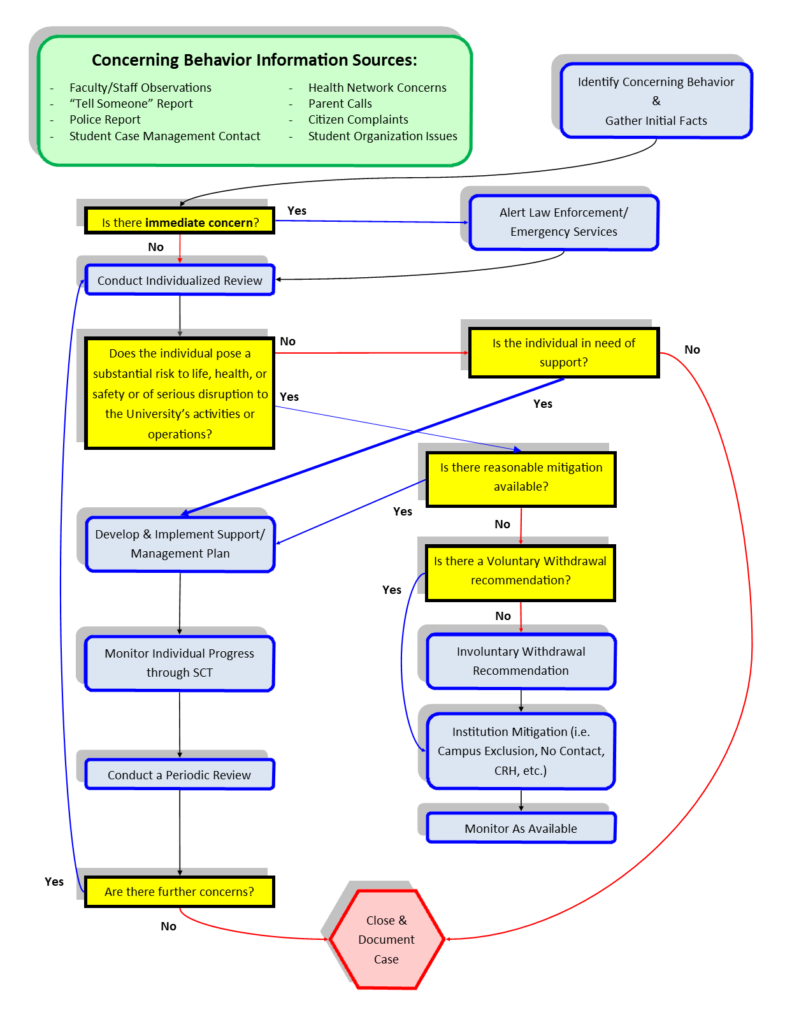CONSULTATION
STUDENT CONSULTATION TEAM
The Student Consultation Team is dedicated to improving community. The team is proactive, objective, supportive, and collaborative. We work to prevent, identify, assess, intervene, manage, and coordinate a response to situations involving students that may pose a threat to the safety and well-being of themselves, other individuals and the university community.Team Members:
- Director of Support and Safety Assessment (Chair)
- Dean of Students
- Director of the Student Resolution Center
- Director of Counseling Services, CSU Health Network
- Director of University Housing
- Director of Student Case Management & Referral Coordination
- General Counsel representative
- Assistant Director of Survivor Advocacy and Feminist Education Center
- CSU Police representative
- Employee Assistance Program Director
- Public Relations representative
- Ad hoc members as needed
EMPLOYEE CONSULTATION TEAM
The Employee Consultation Team is committed to providing a safe educational environment and workplace. The team takes a proactive, objective, coordinated, and supportive approach to identifying, assessing, managing, and reducing behaviors that may be disruptive or pose a threat to the safety and well-being of individuals and the campus community.Team Members:
- Director of Support and Safety Assessment (Chair)
- Director of Counseling Services, CSU Health Network
- General Counsel representative
- CSU Police representative
- Human Resources representative
- Equal Opportunity representative
- Employee Assistance Program Director
- Director of the Student Resolution Center
- Vice Provost for Faculty Affairs
- Ad hoc members as needed
STUDENT CONSULTATION TEAM FLOWCHART

Top of chart begins with: “Concerning Behavior Information Sources: Faculty/Staff Observations, Tell Someone Report, Police Report, Student Case Management Contact, Health Network Concerns, Parent Calls, Citizen Complaints, Student Organization Issues”
First Step: Identify Concerning Behavior and Gather Initial Facts
First Q: “Is there an immediate concern?”
- If “No” there is not an immediate concern, then next step is: “Conduct individualized review”
- If “Yes” there is an immediate concern, then next step is: “Alert law enforcement or emergency services”
- Next step: “Conduct individualized review”
Second Q: “Does the individual pose a substantial risk to life, health, or safety or of serious disruption to the University’s activities or operations?”
- If “No” the individual does not pose a substantial risk to life, health, or safety or of serious disruption to the University’s activities or operations, then go to the third question is “Is the individual in need of support?”
- If “Yes” the individual poses a substantial risk to life, health, or safety or of serious disruption to the University’s activities or operations then next question is “Is there reasonable mitigation available?”
- If “No,” there is not reasonable mitigation available, then next question is “Is there a Voluntary Withdrawal Recommendation?”
- If “No” there is not a voluntary withdrawal recommendation, then next step is “Involuntary withdrawal recommendation
- Next step: “Institutional mitigation (i.e. university grounds exclusion, no contact order, hold on student account, etc.)
- Next Step: “Monitor as available”
- If “Yes” there is a voluntary withdrawal recommendation, then next step is “Institutional mitigation (i.e. university grounds exclusion, no contact, hold on student account, etc.)
- Next step: “Monitor as available”
- If “No” there is not a voluntary withdrawal recommendation, then next step is “Involuntary withdrawal recommendation
- If “Yes,” there is reasonable mitigation, then next step is “Develop and implement support/management plan”
- Next step: “Monitor individual progress through SCT”
- Next step: “Conduct periodic review”
- If “No,” there is not reasonable mitigation available, then next question is “Is there a Voluntary Withdrawal Recommendation?”
Third Q: “Is there an identified impacted individual in need of support?”
- If “No” there is not an identified individual in need of support, then next step is: “Close case and document”
- If “Yes” there is an identified individual in need of support, then next step is: “Develop and implement support and manage plan”
- Next step: “Monitor individual progress through consult team”
- Next step: “Conduct periodic review”
Fourth Q: “Are there further concerns?”
- If “No” further concerns, then next step is: “Close case and document”
- If “Yes” there are further concerns, then next step is: “Conduct individualized review” again and repeat process
